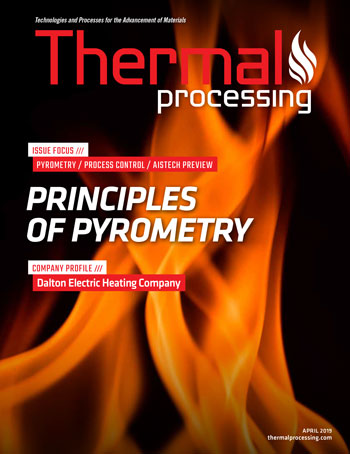
The definition of process control can only be defined by the experience of the per-son to whom the query is presented. Everyone involved in heat-treating who works with the auto industry knows of the CQI-9 standard that covers a multitude of parameters considered critical by the Big Three automakers. Process control of heat treat, or the metallurgical outcome, is but one of these objectives and is merely a result of what has already been preordained by the success of the previous equipment-manufacturing procedures.
One might ask why a standard such as CQI-9 is required in the first place. The obvious answer is to try and find a manufacturing compliance method that will assure when a case-depth specification of 0.030”, +/- 0.005” (0.72 mm, +/- 0.127 mm) is required, it can actually be met by any previously approved supplier in an approved facility. That compliance procedure to the specification is called the Production Part Approval Process (PPAP). How the procedure is carried out can vary according to the specific quality requirements of the product being manufactured — gears, shafts, torsion bars, fasteners, etc.
Generally, a typical part load is agreed upon with a specific number of parts per location in a tray with the process running continuously, or for whatever time period is appropriate. If a nonconforming part is detected during a run, a previously agreed-upon procedure will commence. That can be many things, but usually the equipment supplier will be given the opportunity to correct the suspected reason for noncompliance and either continue the production run from there, if possible, or start from the beginning.
Obviously, before a PPAP, the equipment supplier will be allowed to prepare, debug, or otherwise duplicate a production cycle with a few dummy and real parts to ensure the equipment is as production-ready as possible. Everyone knowledgeable with the equipment knows it’s a complex machine and unexpected mechanical issues can occur. However, as long as the event is considered fixable on the fly without affecting a critical outcome, compromises can sometimes be made. After all, all parties concerned want the equipment to perform to expectations within the mandated schedule.
In heat-treating where the parts are processed in furnaces out of sight, sensors are relied on to measure the temperature of the parts as compared to the set point. TCs (thermocouples) are inserted either through the roof, rear, or side wall as close as possible to the parts and are expected to reflect an accurate representation of the part temperature. That small bead that joins the two different metals forming the hot junction will produce a millivoltage depending on the metals corresponding to the temperature.
The heat energy reaching the TC bead is produced by four elements:
Radiation from the parts in the load.
Radiation from the heating source, tubes, or electric elements.
Radiation from the heated atmosphere gas passing over the bead.
Conductivity of the TC protection cover, usually ceramic or refractory metal, draws heat away from the TC bead toward and through the refractory wall.
In theory, we want the load to provide greatest influence on the TC, and we assume this is so because of the proximity of the TC to the parts. But this condition depends on the furnace type and the interior design.
When a load of parts is charged into a batch furnace, we see the zone TC immediately drop, undoubtedly due to the black parts influencing the TC — again be-cause of its proximity to the load — but also because the refractory and heating source is losing heat to the cold parts. We know that heat energy is transmitted by radiation faster than gas convection, but that’s primarily because the emitting source of the radiation, such as radiate tubes, has much more surface area than the gas atmosphere. However, each electron of every atom of gas also has mass and emits radiation, and the mass or quantity of gas that passes over the TC bead contributes to the temperature increase. Thus, the higher the gas velocity, the greater the transfer of heat via convection. It’s true, gas and convection have a negative component called a boundary layer, where radiant energy does not — in a true vacuum, that is. So, when a cold load is placed into a hot chamber, the radiant energy from the heating tubes or elements must first heat the gas, and then the gas transports that energy to the parts. Of course, the emissivity of the receiver and emitter has a significant influence on the quantity of energy transmitted.
Granted, as the heat penetrates the parts on the exterior of the load, that heat via conduction will flow through to the colder portions of the parts on the interior of the load. It is radiation by convection that provides the energy to heat the interior of the load, all while the TC is measuring the environment in its proximity of the load.
The dilemma for the heat treater is the accuracy of the sensors used to measure those parameters. TCs, gas analysis equipment, and oxygen probes can be certified to traceable standards. But where chemistry and thermal dynamics are involved, reproducibility is not so easy. Why? No two heat-treating furnaces manufactured in the same facility side-by-side will respond the same way while processing the same recipe. There will be minor variations due to all of the tolerances involved with every manufacturing process.
Every possible precaution is taken along the manufacturing supply chain with all of the ISO standards guiding the procedures. However, when furnaces are constructed, humans, not robots, perform the functions. As talented as they are to approve procedures, it’s unlikely two brick masons will apply the “mud” refractory mortar in the identical manner with the exact content of water on every one of the thousands of bricks required in a furnace. The chemical content of the refractory also plays a role. Welding is another critical function that I’ve discussed in earlier columns that can affect atmosphere quality, but likely much later in the furnace’s operating life.
Another aspect of process control is mechanical function. Furnaces, being self-destructive machines, operate best when in a steady state, i.e. operating at the same temperature continuously 24/7. But that’s never the case. Every item or material that makes up the furnace — metal case, rubber, plastic, ceramic, mortar, and refractory — expands and contracts with the heat-treating process. The most susceptible of the mechanical items are the doors, since they are constantly opening and closing thousands of times a month. Most critical are doors that separate the ambient environment from the furnace atmosphere. Second is the inner heat-sealing door; it receives the most wear and tear. In atmosphere furnaces, inner doors are not meant to be gas tight, but rather heat shields to prevent overheating of other components. Atmosphere gas is designed to leak through a designated location, usually at the bottom or a small orifice in the door center. Either way, the leaked atmosphere should pressurize the vestibule that further allows a predetermined leak rate to keep the furnace pressure within proper limits.
The gas sensors, whether they be oxygen probes to measure “oxygen” ppm, infrared analyzers for percent of CO and CO2, or TCs, all must be accurate within empirical limits known to be acceptable.
As with the devices mentioned above, limit switches, valves, doors, seals, and fans constantly perform their functions all while the materials degrade, shrink, and eventually leak — allowing contamination of the unseen process occurring inside the furnace. This is where the typical understanding of process control really hits home, and we all expect the sensors to measure and correct and compensate for all of the previous processes and procedures in the manufacturing chain.
Concerning the atmosphere, endo is used in this case. Endothermic gas — with its ideal mix of 20 percent CO, 40 percent H2 and nitrogen, plus critical fractions of CO2 and H2O, and nascent oxygen with the proper proportions — produces a specific case depth of carbon at the appropriate temperature. Although minor variations of CO will have little effect on an expected outcome, very minor changes in the CO2 and H2O can have a monumental impact. And since those oxidizing components are so paramount to the result, their accuracy is critical. The extent to which heat treaters attempt to control the critical gas compositions is as complex as the heat-treating furnace itself.
Some may argue with my comments here, but my overall goal is to illustrate how over-the-top complex the heat-treating furnace has become since the batch furnace was introduced before World War II. I believe wholeheartedly that since WWII, millions of components requiring heat-treating manufactured for every possible device are still functioning to acceptable standards.
Epilogue
We’ve got to reinvent the heat-treating furnace, get back to the “if it ain’t broke, don’t fix it” philosophy, and simplify, simplify, simplify.
History has repeatedly illustrated that what starts out complex and large eventually becomes simpler and smaller.























